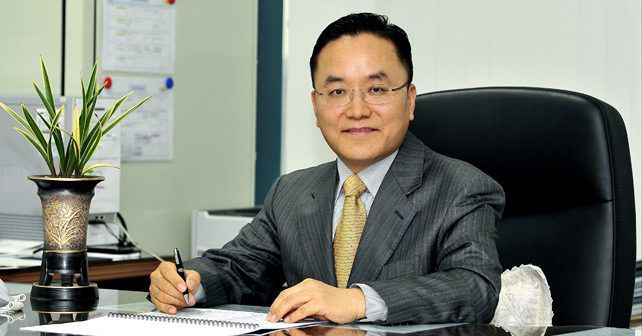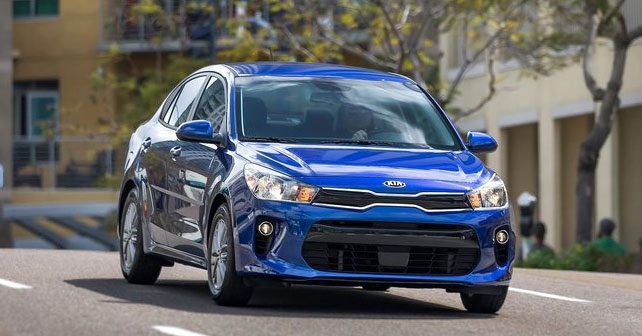
Tae-Hyun (Thomas) Oh is Senior Executive Vice President and Chief Operating Officer, Kia Motors Corp. He’s spent the last 28 years of his career with the Hyundai-Kia Automotive Group – now the fourth largest automotive manufacturer in the world – and is presently in charge of their global sales. He may be nearing three decades in the automotive industry, but you can clearly see that the fire still burns very bright in Mr Oh’s eyes. He perfectly embodies Kia’s ‘Young at Heart’ tagline. He’s grown Kia into a force to reckon with in the global market, and he says that India is the last piece of his puzzle.
Kia Motors will invest US$1.1 billion in a brand new 536-acre manufacturing facility with a 300,000 units production capacity in the Anantapur District of Andhra Pradesh. They expect to start rolling out cars in the second half of 2019. Here’s what Mr. Oh says about Kia’s strategy for the Indian market:
Is Kia’s R&D shared with Hyundai?
Sometimes we share platforms. From a technology standpoint, we do share but we make sure to get different products. Hyundai has their own brand image, and Kia has our own image. Hyundai targets people who are confident and refined. But, at Kia, we’re seeking customers who are young at heart. Our design is also different from each other. Since ‘98/99, when Hyundai took over Kia, we’ve put a lot of energy to make sure the two brands are different.
You’re one of the last global players to come into the Indian market – why has Kia hesitated all this while?
Unless we set up our own plant in India, we can’t sell our cars because the import duties are very high. For example, we put our plant in the United States, we put our plant in Slovakia, and we put three plants in China. We now also have a Mexican plant to supply our products to North and South America. Now we come to the Indian market, this will be the last piece of the puzzle on the way to 4 million cars by 2020.
Do you plan to synergize operations with Hyundai in terms of powertrains and platforms?
From the beginning, we’ll be different from Hyundai – be it line-up, brand image, investment, and dealer development. As for local content, in the long run, we’re aiming at 100%, like Hyundai, but at the beginning we will see what will be the optimal level – 30 or 40%. We’re currently looking at the feasibility.
What kind of volumes would you look for in the short to medium term? You said that India is key for you to meet your 4 million target for 2020.
We will produce around 300,000 units, which is our plant capacity. But Hyundai has reached around 500,000 last year, and Maruti sells around 1.4 million. Toyota produces 100,000 cars and has around 200 dealers, which means they’re selling around 500 cars per dealer. Maruti sells around 1,600 cars per dealer, while Hyundai sells 600 – but it’s taken them 20 years – so we’ll see.
Your plant capacity will be 300,000 units?
Usually, for economies of scale, globally, we typically produce 300,000 units per plant.
Do you plan to export as well from the Indian plant?
Why not? We will digest our production for the Indian market first, and then followed by export – like Hyundai.
Have you decided what your image in India will be – especially since it’s a very crowded market in the volume area?
We have to stand apart from other carmakers. Globally, Kia aims at mainstream brands like Volkswagen – but the Indian case may be different. Currently, we have a consulting project with experts to see what our positioning ought to be and what the brand image should be for our Indian customers. So we’re looking at several scenarios.
In Mexico, we launched in July 2015. Kia’s brand is perceived to be premium for Mexican customers. So, in India too, we could have some mainstream products plus some premium models. We will finalise that strategy very soon.
Are there global guidelines that you have to follow with Hyundai, or could you be more premium than Hyundai in a new market like India?
Usually, globally, Hyundai aims for a more premium image, like BMW for example. But, at Kia, we are looking at mainstream brands like Volkswagen. In India, we will launch products that aim for volumes, while some models may aim at a premium brand image (Kia has subsequently announced that they will produce a compact sedan and compact SUV especially for the Indian market).
When you launch will you come in with a multi product launch – not just a single product?
Definitely multi product – because we will develop quality dealers. If I see only one product in their showroom, they will not be profitable. My philosophy, when it comes to dealer development, is that I want my dealers to be profitable. Of course, when we decide which products to launch in the Indian market we will have meetings with dealer prospects. At that time, we’ll declare that we will make them profitable. If the dealer is profitable, then they will place more orders, we will produce more, and we will be profitable – so it’s a cycle.
You’re looking at the younger generation – the buyers of tomorrow – so globally what is Kia looking at to connect with Gen X?
Don’t get me wrong, when I talk about people who are young at heart that doesn’t just mean the young generation – but also elderly people who are young at heart. Just for example, we launched the Soul in the US back in April 2009. At the beginning, we expected local demand of 150,000 units. Our dealers felt they could sell a maximum of 40,000 since it was a halo model of sorts. I gave them a target of 200,000 units – knowing that Scion (a Toyota sub-brand) was selling a maximum of 100,000 at the time. And now Scion has disappeared. Last year, we sold 150,000 units – which is more than 40% market share in that segment in the United States. So, we have developed our own market. When you come up with something that’s original, you can have great success. But, originally, we thought that we would have customers who would be 30 or 40 years old – but later on we found that a very great portion was coming from senior people who had retired. They found the Soul to be very convenient for getting in-and-out, and they also liked its outstanding design and reasonable price. So, that’s why I say that young at heart doesn’t mean only young people.
In India, would you be looking at co-branded dealerships with Hyundai?
We will have independent dealers. We will not mix with other brands – particularly Hyundai.
So, who would your benchmark in India be – your principal competitors?
We are doing a feasibility study with our consulting company, but I want to focus on customer satisfaction. I look at that commitment as the basic criteria – the customer satisfaction index. And to achieve that the most important thing for us to focus on is dealer prospects. For the Mexican market, we had three phases of dealer development. Maybe in India also we will have three phases to work our way up to 300. I heard that mobilisation in rural areas is much faster than urban areas, so that’s very interesting.
Kia ranked at the top of the JD Power Quality Survey last year, but a lot of brands for India have made some compromises on their global quality levels. So they have a global quality level and then a separate quality level for the domestic market in India. How will you manage challenges like that for a market that is as price sensitive and unique as India?
That’s a very hard, and good, question. We put a lot of energy in improving quality, that’s why last year we were number one in the United States. Porsche, Toyota, and Lexus were all behind us. In the US, we’ve launched a ten-year warranty to prove our quality. In the European and Mexican market, we’ve launched a 7-year warranty. So, when we decide on our warranty policy in the Indian market, then maybe we can use this to communicate our commitment to quality.
Will similar warranty timelines apply for India as well?
Yes, currently, the warranty period in my mind is 7 years. But, we will decide later on. Nevertheless, to deliver a strong message in terms of quality we will launch a very strong warranty strategy.
Which product amongst your range would be ideal to represent Kia in India?
We will appoint a volume model, a cash-cow model, and a brand image model – or a silver bullet model. We are looking at this and are still doing the feasibility study.
When you develop new global products, how much would you say that India will influence what the product eventually becomes? How much would you engineer your products towards the Indian market?
We have accumulated a lot of data. So, for example, I know that Indian customers like to stand apart from the crowd. So, we will reflect these unique Indian tastes into our line-up.
Would you consider engineering products solely for India?
Why not, it depends on our development.
What is Kia banking on in future – technology wise?
We have to be eco-friendly. This year, eco-friendly models will sell 2.3 million cars. Maybe in 2 or 3 years, they’ll reach 5 million cars. We have a very good plan. By 2020, we will replace 70% of our engines with the next generation of engines. And also in terms of weight reduction, we will use more ultra high strength steel. Currently, we are using anywhere from 25-50% depending on the model. But we’ll use more for more weight reduction. Also, we are selling 4 eco-friendly models. By 2020, we’ll sell up to 14 models. And, in the long run, we’ll produce fuel cell vehicles also. We have already developed hybrid and electric vehicles. This year, we’ve launched a plug-in hybrid.
What about an autonomous model?
This is a hot topic globally. Last year, we announced a Drive Wise sub-brand to develop advanced driving assistance technologies. So, by next year, we are investing more than 2 billion US dollars (this is a combined figure for Hyundai and Kia both) to develop such future technology. So, by 2020, maybe we’ll have partially autonomous driving, and by 2030 we may have a full autonomous vehicle as well.
How many common platforms do you share with Hyundai?
Currently, we’ve reduced the number of platforms to seven. But, definitely, we have to share technologies and platforms with them – otherwise there’s no point sharing an R&D Centre. But we also have to be very different from each other.
Do you expect a certain amount of cannibalisation with Hyundai in India?
We will look to be different from Hyundai. Our sister company may already be in India, but we can’t depend on their establishment. We will not confuse the Indian customer. Otherwise, we cannot get incremental sales from a Group standpoint. If we fail, there might be cannibalisation over friendly fire – but we don’t like that. To see incremental sales on the way to 2020, when we expect 6 million sales for Hyundai and 4 million sales for Kia, we cannot afford cannibalisation.
In my business career, the Indian market is the last piece of the puzzle. It’s very important, because I’m a gourmet. As Napoleon said, the real gourmet enjoys the last items of the dish.

























Write your Comment